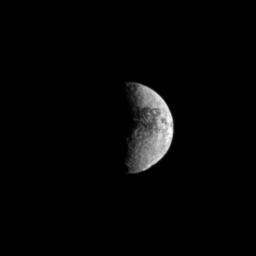Crater at the Edge
Caption:
Craters give a rugged look to surface of Iapetus, especially in the large basin of Engelier visible along the southern limb of the moon in this view.
The two-toned surface of the moon is evident in the dark areas visible near the north's middle latitudes. See
PIA11690
to learn more about the craters and brightness dichotomy on Iapetus.
Lit terrain seen here is on the Saturn-facing side and trailing hemisphere of Iapetus (1,471 kilometers, or 914 miles across). North on Iapetus is up and rotated 9 degrees to the right.
The image was taken in visible light with the Cassini spacecraft narrow-angle camera on Feb. 16, 2010. The view was acquired at a distance of approximately 2 million kilometers (1.2 million miles) from Iapetus and at a Sun-Iapetus-spacecraft, or phase, angle of 88 degrees. Scale in the original image was 12 kilometers (7 miles) per pixel. The image has been magnified by a factor of two and contrast-enhanced to aid visibility.
Background Info:
The Cassini-Huygens mission is a cooperative project of NASA, the European Space Agency and the Italian Space Agency. The Jet Propulsion Laboratory, a division of the California Institute of Technology in Pasadena, manages the mission for NASA's Science Mission Directorate, Washington, D.C. The Cassini orbiter and its two onboard cameras were designed, developed and assembled at JPL. The imaging operations center is based at the Space Science Institute in Boulder, Colo.
For more information about the Cassini-Huygens mission visit
http://saturn.jpl.nasa.gov
. The Cassini imaging team homepage is at
http://ciclops.org
.
Cataloging Keywords:
| Name |
Value |
Additional Values |
| Target |
Iapetus |
Saturn |
| System |
Saturn |
|
| Target Type |
Satellite |
Planet |
| Mission |
Cassini-Huygens |
|
| Instrument Host |
Cassini Orbiter |
|
| Host Type |
Orbiter |
|
| Instrument |
Imaging Science Subsystem (ISS) |
|
| Detector |
Narrow Angle Camera |
|
| Extra Keywords |
Crater, Grayscale, Rotation, Visual |
| Acquisition Date |
|
| Release Date |
2010-03-24 |
| Date in Caption |
2010-02-16 |
|
| Image Credit |
NASA/JPL/Space Science Institute |
| Source |
photojournal.jpl.nasa.gov/catalog/PIA12596 |
| Identifier |
PIA12596 |

 Planetary Data System
Planetary Data System
